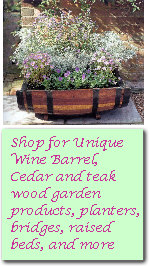We find that
wood containers are one the more popular
container used in the balcony garden. Especially in Metro City areas, we have
been told by some garden and nursery retail stores that customers are telling them besides they
being like the look and feel of the wood planters, some of the town houses, penthouses,
condominiums complex have in their lease or buy agreements that only wood
planters are allowed in their balcony or terraces due to the safety and weigh
limitation concerns ! Other light weight and rustic looking planters are the bamboo planter or
willow planter.
Balcony Gardens bring another dimension to your life!
Being an apartment dweller shouldn't keep you from having a garden. Many
types of gardens can be created on balconies. With the addition of floral color,
a balcony becomes an entertainment center just right for relaxing. Turf, small
shrubs, and dwarf trees can be used to create a suburban landscape in miniature
above the ground. Balconies even offer the opportunity for food production, with
flowering fruit trees and container-grown herbs and vegetables.
Whether transforming a high-rise penthouse or a simple second-floor terrace
into a garden, a set of guidelines will aid in creating your "garden on
high." First, consider how you wish to use the area. Are you looking for a
colorful relaxation area or just privacy from an adjacent high-rise?
Second, evaluate the microclimate. Toward which direction does the balcony
face? Note how much sun the area receives and for how long. If the balcony is
recessed, does direct sunlight reach it at all? If the situation is very open,
will you and your plantings be subjected to buffeting winds and scorching
sunlight? Look at the area with a very critical eye before putting a lot of
money in to the project. Some minor remodeling may need to be done to make the
area inviting to both people and plants.
Safety considerations are another important factor to think about. Most
balconies are required by building safety codes to support 60 pounds per square
foot. Be sure to use a lightweight growing media which can reduce weight by up
to 60% over standard garden soil. Avoid using heavy containers; plastics and
cedar wood are
recommended for low-weight situations.
Once you have evaluated the balcony for comfort and safety,
you may start looking for plant materials. Spend some time reading looking for
information which focus
on container gardening. Choose plants suitable to your site.
Vertical Gardening is also well suit for
gardening in a limited space.
Container gardening often is the easiest solution. Pots and
planter boxes come in a myriad of shapes and sizes, take up little space, and
are movable and easily maintained. Don't be limited to the "usual" standard
annuals. Try long-blooming perennials, which, with a little extra care, can over
winter.
Plant the perennials in large wooden planters. The larger the
soil volume, the more success you will have at over wintering your plants. Avoid
small containers as well as plastic or terra cotta that may crack when the water
you apply in the winter freezes. After the first fall frost, cut the perennials
back, mulch well and move the container to a shaded area. Water two or three
times a month, especially if the containers collect no snow in their winter
location.
In spring, move containers to their permanent location, remove
the mulch and water regularly. Vegetables, herbs, roses and even dwarf fruit
trees can be grown this way. Check the gardening section of your local library
or bookstore for books about container gardening.
The plants on an outdoor balcony will usually be enjoyed indoors as well, so
be sure to plant eye-catching displays where they can be viewed through glass
doors. For example, miniature conifers in a wooden trough offer year-round
viewing pleasure. Clematis trained up a permanent trellis does wonders to
disguise an unsightly view.
Many summer bedding plants are suitable in a sunny, balcony location. Try
grandiflora petunias, graced by big, bright flowers, or compact salvias with red
blossoms on strong, stocky spikes. Even a shady position still provides a
multitude of choices. Experiment with shade lovers including climbing or
trailing ivies; year-round, evergreen plants such as boxwood; and annuals like
impatiens or browallia to brighten sheltered areas.
One popular way to display a variety of plants in a small space is the
"three-tier" design. Upright plants are used against a wall or trellis, or as the centerpiece in a
planter box to add height. Bushy,
medium-height plants fill in the bulk of the container. The planter boxes come
with a lot of sizes and shapes such as rectangle, square, raised legs,
and also bowl which are suitable for shallow
rooted plants materials. Trailing plants placed
on the edges of the planter tumble over the sides softening the composition.
Balconies have been transformed into the "backyards" for thousands
of apartment, condominium, and townhouse dwellers across the country. Be
adventurous. Your balcony may be just the spot.

![]() Gardeners' Corner
Kids'
Garden
Sustainable Garden
Contact Us
Gardeners' Corner
Kids'
Garden
Sustainable Garden
Contact Us![]()


